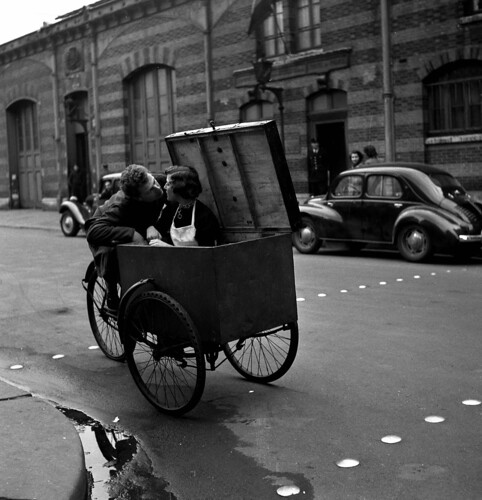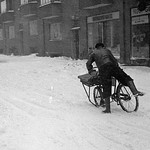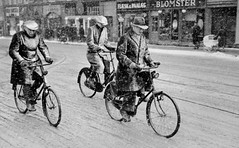

Article originally published on 19 November 2007. Revised November 2015.
Over the years we have realised that a large part of our work at Copenhagenize Design Co. in working towards bicycle-friendly cities is the simple art of mythbusting. While time-consuming and often frustrating, it still appears to a necessary part of the dialogue around the world.
It’s interesting how uniform the misconceptions about cycling are, regardless of where in the world we hear them. It’s equally interesting to hear them coming from people who cycle - not just people who don’t. We know that every city in the world was bicycle-friendly for decades, not least until the 1950s when the urban planning paradigm shifted drastically and destructively and started to focus solely on automobiles. People have short - or selective - memories it would seem. They look around their city and assume that it has always just been like that. Civic pride seems to play a role as well. People in winter cities are proud of their winters and ridicule those cities that have a milder season. The same applies to cities with hot weather. People in topographically-challenged cities enjoy mocking cities with a flat landscape.“People won’t ride bicycles here. It’s too cold/hot/hilly/insert your excuse here”. More often than not, the people uttering these misconceptions are merely projecting their own personal opinion onto the population at large - without any experience or data to back up their claims. It is invariably one of two angles; “I won’t ride a bike here, so nobody will” or “I ride a bike here, I’m hardcore and not everyone is as badass hardcore as me”.
Yeah, whatever. When virtually every city on the planet has enjoyed high levels of cycling in it’s history, we know differently. Singapore? Too hot. Oh, really?
Or Australia? Too bloody hot, mate, and nobody has ever done that in Queensland, New South Wales, Canberra. Yeah, right. Vancouver? Rio de Janeiro? Los Angeles? Dublin?
We could go on.Sure, things are different now. The number of cars has obviously increased in our cities since the 1940s. That’s where infrastructure comes into play. Best Practice infrastructure has been around for a century or so, so there are few excuses left. Designing streets instead of engineering them is key.
We know that infrastructure is the key to increasing cycling levels. We know that we as individuals do not dictate what other will or won’t do. If you make the bicycle the fastest way from A to B to C in a city, people will ride. Maybe never 56% of the population - like in Copenhagen - will ride in, say, San Francisco but 20% is certainly a respectable and achieveable target for any city.Myth #1 - Hills
Damn you, Netherlands. Your flat, little country is making our mythbusting hard. It’s got to be the primary lame excuse that we hear around the world. “But The Netherlands is flat”. Sometimes accompanied by, “and so is Denmark/Copenhagen”. Punctuated with demonstratively crossed arms as though the discussion is sooo over. It’s not. Sure, the Netherlands is a flat country. It's a carpenter's dream. Do 26% of the population ride a bike each day because it’s flat? No. It helps, sure, but it’s the infrastructure. The bicycle is the fastest way from A to B. To work or school or that train station. Copenhagen is also rather level. At least the Copenhagen that 95% of the tourists visit. They don’t cycle very far outside the city to the north, to the hills where the 2011 Cycling World Championships placed their finish line.
Looking around the rest of the nation - which nobody we talk to ever does - you see topography that is considerably more Rubenesque. In the Danish national anthem, the hills and valleys are proudly lauded. Some people google “highest point in Denmark” and use that to say, “See?!”. As though a rolling landscape and steep streets are not possible if you don’t have a Mont Blanc on your map. As a British friend discovered a few years ago, the hills will surprise you.
Indeed, if you ride around Denmark’s second-largest city, Aarhus, you’ll feel some burn in your thighs as you head home with groceries in your bike basket. And yet the city has 18% modal share for bicycles. Aarhus compares to Sydney, Seattle, Gothenburg or Oslo. Looking back in history, we can see that cycling through the rolling English countryside over a century ago, was hardly an unusual transport option.”In the late 19th century, large numbers of women were already using bicycles to get to work, women office workers and shop assistants wending their way each weekday morning from the suburbs to the town. They found the bicycle a convenient form of transport for distances up to, say, ten miles”.
From John Woodeforde's book ”The Story of the Bicycle”, 1970 This was also in an age where bicycles were machines that we would regard as incredibly heavy to us today. In heavy dresses and thick fabrics to boot. Bicycles these days are considerably easier to ride that back in the late 19th century.Looking at North America, two of the cities that are doing most to reestablish the bicycle as transport on the urban landscape are San Francisco and Vancouver. I have ridden bicycles in over 60 cities around the world. I rolled up and down the hills of San Francisco on a one-speed Biomega, together with friends on upright bikes. I was unimpressed. And I’m just a normal schmuck in normal clothes, not some Captain Spandex MAMIL. Living in Vancouver years ago, I rode from Lynn Valley to downtown each day.
Let’s cast a glance at Japan. The third-greatest cycling nation in the world with 15% modal share nationally. Tokyo, too, has 15% modal share and I can tell you from experience that there are hills. Like so many other cities where people used to cycle and are cycling again.Of course, the e-bike industry uses hills as their primary fear factor to get people to buy their products and they are keen to erase all memory of bicycle-friendly cities over the past 130 years in order to do so. Their thick cloud of hype is focused on sales, not rationality or historical evidence. Follow the money.
Horizontal Hills
Hills are one thing, but it’s suprising that the wind is often left out of the equation. Not out of the equation in Denmark and the Netherlands, though, since we are constantly at the mercy of the blustery whims of the North Sea. The Dutch pro cyclist Johnny Hoogerland has said what we all know in the Netherlands and Denmark. He compared riding in the wind-swept Netherlands to riding in the Pyrenees. A stiff headwind can be the same as a mountain climb, basically. Indeed, we did some calculations at Copenhagenize Design Co.. We measure windspeed in metres per second in Denmark. We figured out that cycling in a headwind of 10 m/s is the equivalent to cycling up an 8% grade. That’s about 36 km/hour and that’s the low end of the average during the winter in Denmark. Welcome to our life for several months a year here in Copenhagen. Hills end, the wind doesn’t. Believe me. As cities around the world are improving conditions for cycling with infrastructure, this mythbusting lark is getting a bit less taxing. It’s so much easier now to point to cities that slap misconceptions firmly round the head.
Myth #2 - It’s so HOT! You can't ride when it's hot!
"People won’t ride here, you see. It’s too hot." Oh. Really? Get yourself a passport. Travel to… oh, let’s say… Seville? Go there in the summer. The city went from 0.2% on bike to 7% in under five years because of their implementation of an infrastructure network despite the blazing heat. What about one of South America’s best cycling cities, Rio de Janeiro? Or Barcelona? Or any number of muggy, hot places where the bicycle thrived and is thriving once again. Like it used to in tropical Cairns, Australia and other places in Queensland. Or in Singapore. Or everywhere else.
Myth #3 - But we have WINTER here! Meteological circumstances are so often married to civic pride. Back in 2008, when I posted some photos here and on Copenhagen Cycle Chic of Copenhageners cycling in the snow, men from - largely - Montreal and Minneapolis were quick to comment on the fact that THAT wasn’t winter. WE have winter. Adding links to Wikipedia about Denmark’s mild climate. Mild compared their theirs, of course. Weather as a phallus symbol, apparently.
The winters of 2009/10 and 2010/11 in Denmark, however, were far more lively with regards to weather. Long, hard winters the both of them. After I started posting photos of rush hours in snowstorms, it all went a bit quiet. The occasional peep about “real winter temperatures” was heard, but generally the photos hammered the point home. A large collection of them are now on Tumblr on our the Copenhagen Viking Biking blog and the VikingBiking hashtag.
So winter cycling is a thing, and has been since the bicycle was invented.Vintage Winter Cycling in Denmark
Copenhagen’s climate change lot is that winters are milder now than they used to be (I have suffered through countless stories from my Dad about how winter in Denmark used to be REAL winter) but the fact remains that there are cities who are just getting on with it. So much so that there is now a Winter Cycling Conference each year.
It started in Oulu, Finland, a city of almost 200,000 people where 14% cycle all winter up there near the Arctic Circle. In 2016, it will take place in Minneapolis. A city which also appears on The Copenhagenize Index for 2015. But wait… you can’t cycle in the winter?! It’s all so confusing. Whatever you do, don’t tell the good people of Umeå, Sweden or any number of other cities....
In the winter vein, we have noticed through the years that the “hardcore” really want to show how badass they are. They make every effort to totally overcomplicate winter cycling and - in the process - make it inaccessible for the 99%.
The winter is an easy thing to tackle with infrastructure that is prioritized for snow clearance. There is, admittedly, larger challenges like Climaphobia and living in Vaccuum-packed Cities. But hey. Let’s start somewhere. Infrastructure. And keeping it clear of snow. In Copenhagen, the cycle tracks are cleared first. No discussion. Here is a map of the on-street cycle tracks in the city and next to it a map of the bicycle infrastructure (including off-street) that are prioritized first when it snows. Here is an article about how the City of Copenhagen does it and encourages 75% of all cycling citizens to continue all winter.
With Best Practice infrastructure and maintenance of it you effectively make winter obsolete or, at least, tame it.Myth #4: We have sprawl!
Many North American cities are, indeed, urban sprawls but we often get people commenting on the fact that American cities are WAY too big to ride in compared to European cities.We’ve been here before with the Busting Urban Sprawl Myths article here on the blog.
Copenhagen has sprawl. The third-largest urban sprawl in Europe, actually. People commute for a hour and a half or more by car to get to the city, like many other places. Intermodality is the key. Riding your bicycle to the local train station - combining travel modes - helps increase bicycle share. The main point here is that few people are going to ride long distances. Over a century of experience would dictate this. Sure, as quoted above, many “found the bicycle a convenient form of transport for distances up to, say, ten miles”. We know from years of data in Denmark and the Netherlands that the vast majority cycle up to 7 km. In fact, only 7% of the few hundred thousand cyclists in Copenhagen each day ride farther than that. It’s related to anthropology. Humans prefer 30 minutes as the maximum time they want to transport themselves under their own power. Many medieval cities, Copenhagen included, end up at about 20-30 minutes across on foot. 30 minutes is about 7 km for most regular citizens. The low-hanging fruit is planning first for the majority. Add to that the fact that 50% of Americans live within 8 km (5 miles) of their workplace. That's a lot of Americans who we could plan infrastructure for before worrying about sprawl.
Myth #5: You can’t do THAT on a bike
 In regions where the only cyclists seen on the streets are dressed up in lycra uniforms, it’s fair enough for others to think that bicycle load capacity is limited to a water bottle, on-board computer and an energy bar. Short memories apply here, too.
In regions where the only cyclists seen on the streets are dressed up in lycra uniforms, it’s fair enough for others to think that bicycle load capacity is limited to a water bottle, on-board computer and an energy bar. Short memories apply here, too.
Nevertheless, there be myths to bust and we’ve done this a couple of times before. The Australian car insurance company NRMA tried to show the all-round malaise you will suffer in a life without a car. We presented counter claims based on what we’ve seen around Copenhagen.
The American car share company Zipcar used the same approach and, again, we battled back.
We know from daily experience in Copenhagen what is possible, especially with cargo bikes but let’s not forget the research from our Cyclelogistics project that showed that 51% of all goods moved by motorised vehicles in a city could be moved by bicycle or cargo bike.
Myth #6: The Danes and Dutch have always done it. It’s their culture. Yes, they have. Well, except for the couple of decades when car-centric urban planning almost eradicated bicycle traffic. Fortunately, both nations started rebuilding their infrastructure in the 1970s and 1980s. Copenhagen wasn’t “Copenhagen” for a very long while. They have always done it - but then so has everyone else. Bicycles as transport are not culture specific. Like we’ve said, virtually every city in the world had respectable levels of bicycle traffic for decades. The modal share for bikes in Los Angeles a century ago? 20%. We don't call it "bicycle culture", you people do. We just call it transport. What the Danes and the Dutch have that is unique is that they have focused for more than a century on regular citizens cycling. Social inclusion, health benefits, etc. The Dutch even banned betting on cyclesports for a period in the 1920s in order to re-establish the focus on transport. In both countries there have always been NGOs for regular cycling that were separate from the sports organisations. This was the case in most countries early on, but countries like Sweden and Germany saw their two different types of cycling organisations merge and end up being dominated by the cycle sports angle.
This is changing, with cycling NGOs for The 99% gaining in influence and finding their focus once again.
We know that not everyone is going to cycle everywhere all the time. The goal is simply well-designed bicycle infrastructure networks, smooth intermodality between modes of transport that include the bicycle and taking the bicycle seriously as transport once again. That's not so hard, is it?Basically, whatever myth or misconception people can think up, there are people proving them wrong somewhere in the world at any given moment. Mythbusting is time-consuming and often frustrating but it is a necessity. For a while longer, at least.







